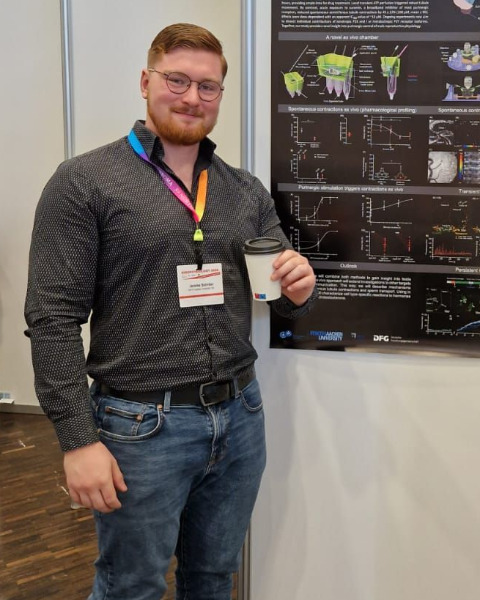Testis/Sperm
Poster Session A
(P-468) In Vivo Investigation of Ca2+Signaling in Seminiferous Tubules.
Wednesday, July 17, 2024
8:00 AM - 9:45 AM IST
Room: The Forum

Jerome Schroeer
PhD Student
RWTH Aachen University
Aachen, Nordrhein-Westfalen, Germany
Poster Presenter(s)
Abstract Authors: Jerome Schröer 1, David Fleck1, Justine Fischoeder 1, Christopher Wiesbrock1, Marc Spehr1
1. Institute for Biology II, Department of Chemosensation, RWTH Aachen University, Germany
Abstract Text: The life-long process of fertile sperm production is a fundamental mechanism of reproduction. Nevertheless, the complex and precisely orchestrated mechanisms behind this phenomenon largely remain a black box. To gain insights into these mechanisms we focus on the seminiferous tubules, the primary functional units of mammalian testis, and its three main cell types, i.e., peritubular, germ, and Sertoli cells. We address cell type specific Ca2+ signaling due to its established role in regulation of cellular activity. Here, we use in vitro and in vivo life cell imaging approaches to study non-evoked Ca2+ signaling events in all three cell types. We employ Cre-loxP genetics to conditionally express the genetically encoded fluorescence Ca2+ reporter GCaMP6f. Our studies show that all three cell types exhibit distinct Ca2+ signaling patterns with unique characteristics. We demonstrate that Ca2+ activity is both age- and endocrine state-dependent, and it is affected by gonadotropins such as FSH and LH. Moreover, cross-correlation analysis reveals unexpected coordinated ensemble activity. Collectively, our findings provide a deeper understanding of male reproductive physiology.
1. Institute for Biology II, Department of Chemosensation, RWTH Aachen University, Germany
Abstract Text: The life-long process of fertile sperm production is a fundamental mechanism of reproduction. Nevertheless, the complex and precisely orchestrated mechanisms behind this phenomenon largely remain a black box. To gain insights into these mechanisms we focus on the seminiferous tubules, the primary functional units of mammalian testis, and its three main cell types, i.e., peritubular, germ, and Sertoli cells. We address cell type specific Ca2+ signaling due to its established role in regulation of cellular activity. Here, we use in vitro and in vivo life cell imaging approaches to study non-evoked Ca2+ signaling events in all three cell types. We employ Cre-loxP genetics to conditionally express the genetically encoded fluorescence Ca2+ reporter GCaMP6f. Our studies show that all three cell types exhibit distinct Ca2+ signaling patterns with unique characteristics. We demonstrate that Ca2+ activity is both age- and endocrine state-dependent, and it is affected by gonadotropins such as FSH and LH. Moreover, cross-correlation analysis reveals unexpected coordinated ensemble activity. Collectively, our findings provide a deeper understanding of male reproductive physiology.
